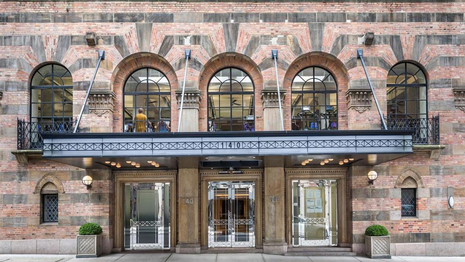Nobody Asked Me, But… No. 228: The Barbizon Hotel, New York | By Stanley Turkel

Nobody Asked Me, But… No. 228: The Barbizon Hotel, New York
Barbizon Hotel |
Hotel History: Barbizon Hotel, New York
The Barbizon Hotel for Women was built in 1927 as a residential hotel and clubhouse for single women who came to New York for professional opportunities. Designed by the prominent hotel architects Murgatroyd & Ogden, the 23rd-story Barbizon Hotel is an excellent example of the 1920s apartment hotel and is notable for its design quality. The Barbizon's design reflects the influence of architect Arthur Loomis Harmon's enormous Shelton Hotel in New York. Harmon, who would help design the Empire State Building a few years later, made visionary use of the city's 1916 zoning law to admit light and air to the streets below.
In the period following World War I, the number of women attending college began to approach that of men for the first time. Unlike the graduates of preceding generation, three quarters of whom had intended to become teachers, these women planned on careers in business, the social sciences or the professions. Nearly every woman student expected to find a job upon graduation in a major city.
The demand for inexpensive housing for single women led to the construction of several large residential hotels in Manhattan. Of these, the Barbizon Hotel, which was equipped with special studio, rehearsal and concert spaces to attract women pursuing careers became the most renowned. Many of its residents became prominent professional women including Sylvia Plath, who wrote about her residence at the Barbizon in the novel The Bell Jar.
The Barbizon's first floor was equipped with a theater, stage and pipe organ with a seating capacity of 300. The upper floors of the tower contained studios for painters, sculptors, musicians and drama students. The hotel also included a gymnasium, swimming pool, coffee shop, library, lecture rooms, an auditorium, a solarium and a large roof garden on the 18th floor.
On the Lexington Avenue side of the building, there were shops including a dry cleaner, hairdresser, pharmacy, millinery shop and bookstore. The hotel also leased meeting and exhibition space to the Arts Council of New York and meeting rooms to the Wellesley, Cornell and Mount Holyoke Women's Clubs.
In 1923, Rider's New York City Guide listed only three other hotels catering to businesswomen: the Martha Washington at 29 East 29th Street, the Rutledge Hotel for Women at 161 Lexington Avenue and the Allerton House for Women at 57th Street and Lexington Avenue.
The Barbizon Hotel advertised that it was a cultural and social center which included concerts on radio station WOR, dramatic performances by the Barbizon Players, the Irish Theater with actors from the Abbey Theater, art exhibits, and lectures by the Barbizon Book and Pen Club.
This rich cultural program, the special studio and rehearsal rooms, reasonable prices and complimentary breakfasts attracted many women pursuing careers in the arts. Notable residents included the actress Aline McDermott while she was appearing on Broadway in the Children's Hour, Jennifer Jones, Gene Tierney, Eudora Weltz and Titanic survivor Margaret Tobin Brown, star of the Unsinkable Molly Brown who passed away during her stay at the Barbizon in 1932. During the 1940s, several other performers resided at the Barbizon including comedian Peggy Cass, musical comedy star Elaine Stritch, actress Chloris Leachman, future first lady Nancy Davis (Reagan) and actress Grace Kelly.
The Barbizon Hotel has been the location of the following popular cultural performances:
- In the critically acclaimed television series Mad Men, The Barbizon is noted as the place of residence of one of Don Draper's post-divorce love interests, Bethany Van Nuys.
- In the 1967 Nick Carter spy novel The Red Guard, Carter books his teenage god-daughter into The Barbizon.
- In the 2015 Marvel TV Series Agent Carter, Peggy Carter lives in the Griffith, a fictional hotel heavily inspired by The Barbizon and located on 63rd Street & Lexington Avenue.
- In Sylvia Plath's novel, The Bell Jar, The Barbizon is prominently featured under the name "The Amazon". The novel's protagonist, Esther Greenwood, lives there during a summer internship at a fashion magazine. This event is based on Plath's real-life internship at the magazine Mademoiselle in 1953.
- In Fiona Davis's debut novel, The Dollhouse, The Barbizon Hotel is featured in a fictitious coming-of-age story that details two generations of young women whose lives intersect.
- Michael Callahan's debut novel Searching For Grace Kelly, is set in 1955 at The Barbizon. The novel was inspired by Callahan's 2010 article about The Barbizon in Vanity Fair, titled Sorority On E. 63rd
By the mid 1970s, the Barbizon was beginning to show its age, was half filled and losing money. A floor-by-floor renovation was begun and in February 1981 the hotel began accepting male guests. The tower studios were converted to expensive apartments with long leases in 1982. In 1983, the hotel was acquired by KLM Airlines and its name was changed to the Golden Tulip Barbizon Hotel. In 1988, the hotel passed to a group led by Ian Schrager and Steve Rubell, who planned to market it as an urban spa. In 2001, the hotel was acquired by the Barbizon Hotel Associates, an affiliate of BPG Properties, which operated it as part of its Melrose Hotel chain. In 2005, BPG converted the building into condominium apartments and renamed it the Barbizon 63. The building includes a large indoor pool which is part of the Equinox Fitness Club.
The NYC Landmarks Preservation Commission added the building to its roster in 2012, noting that the structure is "an excellent representative of the 1920s apartment hotel building and is notable for the high quality of its design." My New Book "Hotel Mavens Volume 3: Bob and Larry Tisch, Curt Strand, Ralph Hitz, Cesar Ritz, Raymond Orteig" has just been published.
My Other Published Hotel Books
- Great American Hoteliers: Pioneers of the Hotel Industry (2009)
- Built To Last: 100+ Year-Old Hotels in New York (2011)
- Built To Last: 100+ Year-Old Hotels East of the Mississippi (2013)
- Hotel Mavens: Lucius M. Boomer, George C. Boldt, Oscar of the Waldorf (2014)
- Great American Hoteliers Volume 2: Pioneers of the Hotel Industry (2016)
- Built To Last: 100+ Year-Old Hotels West of the Mississippi (2017)
- Hotel Mavens Volume 2: Henry Morrison Flagler, Henry Bradley Plant, Carl Graham Fisher (2018)
- Great American Hotel Architects Volume I (2019)
All of these books can be ordered from AuthorHouse by visiting www.stanleyturkel.com and clicking on the book's title.
If You Need an Expert Witness: For the past twenty-seven years, I have served as an expert witness in more than 42 hotel-related cases. My extensive hotel operating experience is beneficial in cases involving:
- slip and fall accidents
- wrongful deaths
- fire and carbon monoxide injuries
- hotel security issues
- dram shop requirements
- hurricane damage and/or business interruption cases
Stanley MHS, ISHC Turkel
United States - New York, Phone: +1 917 628 8549
Email: stanturkel@aol.com
Stanley Turkel, MHS, ISHC
www.stanleyturkel.com/
147-03 Jewel Avenue
USA - Kew Gardens Hills, NY 11367
Phone: 917-628-8549
Email: stanturkel@aol.com
Stanley Turkel, Hotel Man, Historian, Civic Gadfly, and Social Activist, Dies at The Age of 96
Nobody Asked Me, But… No. 270: Hotel History: Hotel Martinique (1910) | By Stanley Turkel
Nobody Asked Me, But… No. 269 Hotel History: Paso Robles Inn (1891) | By Stanley Turkel

